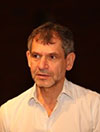ARCHIVE PROGRAMME 2014
TUESDAY 24 JUNE 2014
| CONFERENCE DAY 1 | ||
| 09:00 Opening of MIDI 2014 | ||
| 09:00-10:00 | Patrizia Marti, University of Siena (Italy) | Keynote talk: In Praise of Beauty and Enchantment Abstract |
| 10:00-10:30 Coffee break | ||
| SESSION 1 - METHODS AND CONCEPTS | ||
| 10:30-11:00 | Lapin K. | Deriving Usability Goals for Mobile Applications |
| 11:00-11:30 | Buchalska I. | User Interface - Legal Protection |
| 11:30-12:00 | Kwiatkowska J., Szostek A., Lamas D. | Design and Business Gaps: From Literature to Practice |
| 12:00-12:30 | Sousa S., Lamas D., Shmorgun I. | A Design Space for Trust-enabling Interaction Design |
| 12:30-13:00 | Bobkowska A. | Software Modeling from the Perspective of Intuitive Information Processing |
| 13:00-14:00 Lunch break + coffee | ||
| SESSION 2 - INNOVATIONS, SERVICES, CREATIVITY, EDUCATION | ||
| 14:00-14:30 | Kwasnik M. | Nature of Creativity in Computer Science Education: Designing Innovative Workshops for CS Students. |
| 14:30-15:00 | Garnik I. | Just Let Me Think: Designing Against Acquired Illiteracy |
| 15:00-15:30 | Wichrowski M. | Teaching Digital Interactive Storytelling in Practice: DVD-Video, Blu-Ray Disc and Web Solutions |
| 15:30-16:00 Summary of Day 1 | ||
| 19:00 Social event - trip and party | ||
KEYNOTE SPEAKER
Patrizia Marti - University of Siena, Italy and
Eindhoven Technical University, the Netherlands
Profile:
Patrizia Marti is a Senior Researcher at the Department of Social, Political and Cognitive Science Department, University of Siena (I) where she teaches Human-Computer Interaction and Robotics and Learning. She has received her Ph.D at the Eindhoven Technical University (NL), Faculty of Industrial Design, where she also works as a Full Professor part-time. Her research interests range over a broad range of topics - including human-centred design, interaction design, learning and special education, design of e-health applications, human-robot interaction, design and validation of complex systems and societal impacts of new technologies. Prof. Patrizia Marti has also contributed to the design and development of innovative technologies for health care and rehabilitation. She co-founded a research and consultancy firm which has nowadays a recognized international reputation. The company, Deep Blue (www.dblue.it), operates in the field of design and validation of complex human-machine systems and is regularly used by national and European agencies, to carry out work in the air traffic management field.
More info: www.patriziamarti.it
Keynote talk:
In Praise of Beauty and Enchantment
Abstract:
Addressing people in a respectful manner is what we consider to be our main duty while designing intelligent products and systems. This concept emphasizes the experience of using technology, which leads to feelings of emotional engagement, resonance, beauty, enchantment and wonder, through rich, natural, and meaningful interaction paradigms. Respectful products and systems also imply respectfully addressing human capabilities, in the perceptual-motor, emotional, cognitive, and social skills. The challenge is to design novel applications that are inviting, witty and playful, original and fascinating, poetic, and that can improve life on an individual or societal basis. This vision requires societal, cultural and aesthetic sensitivity to be achieved.
In this keynote talk, I will review different design cases exploring novel interaction paradigms. I will show how to take inspiration from art and poetry and how to play with the subtleties of those languages, to reflect on values (aesthetic, social, ethical) and use them to drive the design process for interactive products and services.
WEDNESDAY 25 JUNE 2014
| CONFERENCE DAY 2 | ||
| 09:00-10:00 | Dariusz Madej, Motorola (USA) | Keynote talk: Interaction Design Practices at Motorola Abstract |
| 10:00-10:30 Coffee break | ||
| SESSION 3 - USER-BASED STUDIES | ||
| 10:30-11:00 | Mottus M., Lamas D., Tokranova D. | Evaluating Aesthetics During Interaction Episodes |
| 11:00-11:30 | Sharma A., Hawkey K. | Understanding the Tradeoffs of Mobile Device Output Modalities in Just-in-time Learning of Mechanical Tasks |
| 11:30-12:00 | Shmorgun I., Lamas D. | Exploring the Use of the Human-Artifact Model for Studying Ubiquitous Interactions |
| 12:00-12:30 | Mehta M., Corradini A. | An Approach to Behavior Authoring for Non-Playing Characters in Digital Games |
| 12:30-13:00 | Juźwin M., Adamska P., Rafalak M., Balcerzak B., Kąkol M., Wierzbicki A. | Effects of Gamification Approaches on Web Content Credibility Evaluation |
| 13:00-14:00 Lunch break + coffee | ||
| SESSION 4 - ENGINEERING INNOVATIONS IN DEVELOPING INTERACTIVE PRODUCTS | ||
| 14:00-14:30 | Kühn M, Forbrig P. | Mobile Data Collection Forms Based on DSLs with Different Levels of Abstraction |
| 14:30-15:00 | Saif M.B., Neubert M, Spengler S., Beckerle P., Felzer T., Rinderknecht S. | Multi-Signal Virtual Keyboard (MSVK): Use of Various Sensors to Replace the Standard Keyboard - First Steps |
| 15:00-15:30 | Szymański J.M., Chynał P., Sobecki J. | Actiontracking in Gesture Based Information Systems |
| 15:30-16:00 | Tisancin T., Sporka A., Polacek O. | EMG Sensors as Virtual Input Devices |
| 16:30 Closing and summary | ||
| 16:30-19:00 Farewell drink and snack - Interactive lab & demos | ||
KEYNOTE SPEAKER
Dariusz Madej - Motorola (USA)

Profile:
Dariusz Madej is a Distinguished Member of Technical Stuff at Motorola Solutions, where he is involved in technology development in the domain of image processing and bar code decoding. He studied computer science at the Politechnika Warszawska and received his Ph.D from Polish Academy of Sciences, Institute of Fundamental Technological Research. From 1991 to 1994 he thought at the Bilkent University in Ankara, Turkey. He published two popular books on computers in Poland, and twenty research papers in conference proceedings and journals. He also gave talks in scientific seminars and conferences in US, Canada, Italy, China, Japan, Sweden, France, and Poland. He holds twenty issued patterns with ten more pending. He is also representative of Motorola in bar code standard committee. He collaborated with University of Minnesota, Stony Brook University, New York Polytechnic University, and University of Split. He lives with his family on Long Island, New York.
Keynote talk:
Automatic object identification. How bar codes and bar code readers transformed to serve users needs.
Abstract:
Bar codes are one type of marks used for automatic identification of objects. They grew from a niche product to become a global phenomenon and had an important role in improving of productivity. Bar codes evolved from on-dimensional symbols that represent a look-up index of an item to a 2D form suitable of containing a data file. They are usually printed on paper, but can be edged or pinned or engraved in metal, plastic or other material. They are being used to identify vast range of items: from merchandise, to parts of machinery, surgical devices to living animals. Presentation will address how bar codes changed to serve those purposes and how readers evolved to allow intuitive and efficient operation in a range of applications. Talk will also demonstrate how bar code are becoming a form of artwork and design, and also show what the future of automatic identification might be.
























